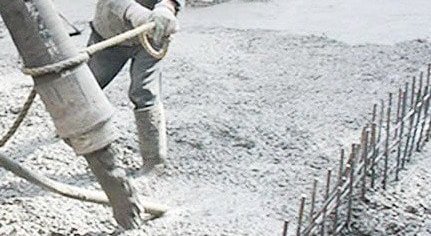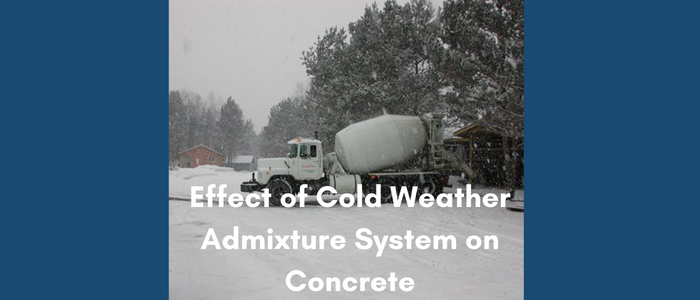This article Effect of Cold Weather Admixture System on Concrete will be divided in two parts to avoid lengthy posting. This first part will deal with the effect of Cold Weather Admixture System (CWAS) on the fresh properties of concrete.

Before starting, I would like to mention that have multiple articles that discuss cold weather concreting. You may want to check for them before starting.
CONSTRUCTION PRACTICES FOR COLD WEATHER CONCRETING
COLD WEATHER CONCRETING: DEFINITION, ISSUES, AND PRECAUTIONS
Effect of CWAS on Concrete Fresh Properties
Fresh properties of concrete are those properties that are of concern when concrete still in the fresh state. Let us look on how CWAS affect the fresh properties of concrete
Effect of Cold Weather Admixture System on Concrete Workability
Workability of concrete is an important factor for fresh concrete. It determines the amount of effort needed to ensure the homogeneity of concrete during the different processes of mixing, placing, compaction and finishing.
Fresh concrete should have the right consistency for the application in order to make concrete of the highest quality. Otherwise, inadequate workability may result in decreased compressive strength and durability problems.
For cold weather, concrete will lose 20 mm of its slump for every 11℃ decrease in its temperature.
Low slump values are advised by ACI 306R while pouring concrete in cold weather to minimise the risk of water bleeding onto the surface. The strength and frost resistance of the surface will be reduced by excessive water bleeding, which may cause durability problems such surface scaling.
Therefore, to accept CWAS into practice, the modified mixtures must give almost the same performance as normal concrete.
Concrete slump may increase from 40 to 60 mm when calcium nitrate cement is used at a rate of 6 percent by weight. This is due to calcium nitrate’s capacity to act as a plasticizer, which improved the workability of concrete.
Thus, increasing calcium nitrate dosage will increase concrete slump whether the concrete was air entrained or not.
Using combinations of anti-freeze admixture will also increase the workability level of concrete. For example, a study by Karagol showed that using 9% calcium nitrate, 9% urea and combination of 4.5% urea + 4.5% calcium nitrate by weight of cement increased the workability of concrete from 40 mm to 60, 120 and 220 mm at room temperature, respectively.
Effect of Cold Weather Admixture System on Concrete Setting time and heat of hydration
Reducing the setting time of concrete leads to reduction of the protection period and minimizing the possibility of mixing water freezing. At freezing temperatures, concrete sets at slower rate which adversely affects the construction schedule and increase time and manpower to finish the job.
According to research, the setting time increases by around 30 to 35 percent for every 6°C drop in ambient temperature.
ACI 306R recommends in cold weather concreting to use extra cement, rapid setting cement or accelerating admixtures to reduce the setting time of the concrete to shorten the protection period.
The use of antifreeze admixtures can depress the freezing point of mixing water and prevent ice formation, thus concrete hydration may continue leading to faster hardening and setting time of concrete, and consequently faster strength gain.
Calcium chloride could shorten the value of initial and final setting times of concrete. Also, mixtures of calcium and sodium chlorides reduces the setting time.
In addition, increasing chloride content in concrete can lead to high early heat of hydration and cracking due to the acceleration effect.
Using potash (K2CO3) as an antifreeze additive will have the same accelerating effect and high early heat of hydration.
In contrast, it has been demonstrated that urea acts as a retarder because of its interaction with water, which absorbs heat and slows the hydration of cement.
Effect of Cold Weather Admixture System on Concrete Air Content
In order to increase concrete resistance to freezing and thawing cycles, high air content—typically 4 to 8 percent by volume—is necessary regardless of the concrete mix design specifications.
The hydraulic and osmatic pressures brought on by freezing and thawing cycles can be somewhat relieved by entrained air gaps.
For concrete mixtures subjected to freezing and thawing cycles, a 6%±1 air void content is ideal.
Using 4 and 8 % of calcium nitrate as antifreeze admixtures has no effect on neither the capillary pores nor the air-entrained voids of fresh concrete at 20℃.
Some other antifreeze admixtures may actually increase the air content.
According to ACI 306R, air entraining admixtures become ineffective when in contact with hot mixing water, which makes it detrimental to heat combination components like aggregate and water to high temperatures and encourages the usage of CWAS.
Read the second part here on the effect of CWAS on hardened concrete
